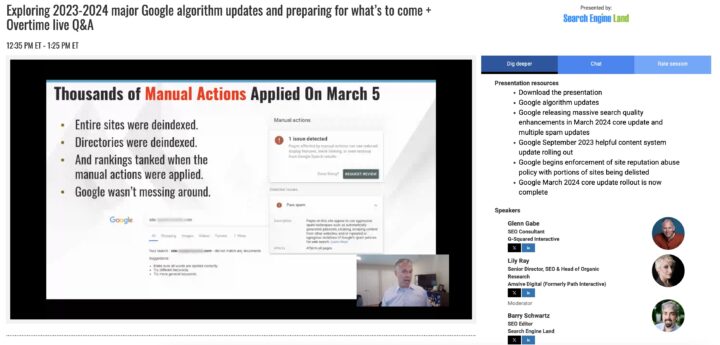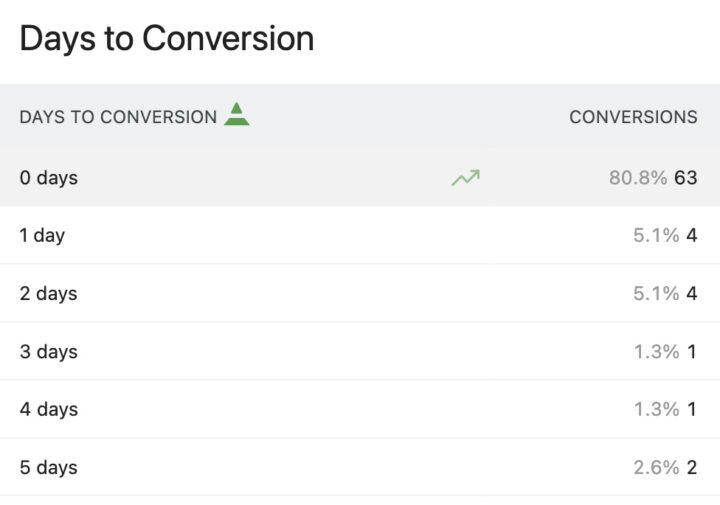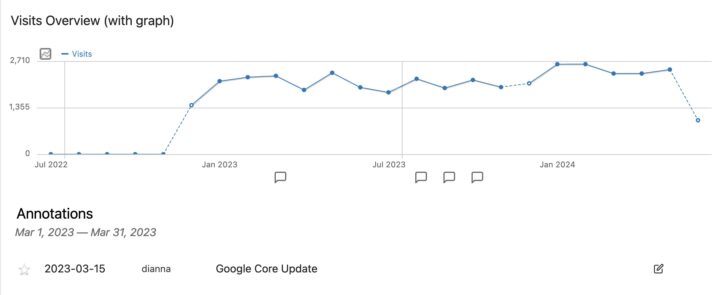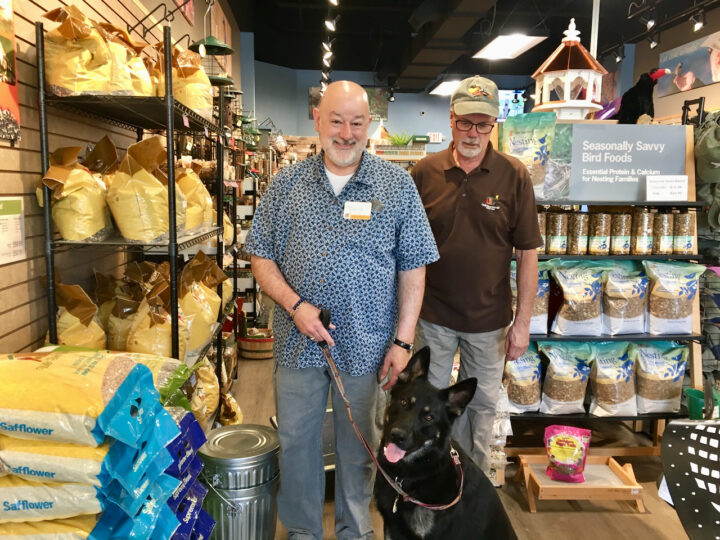In case you’ve missed it (and it’s ok if you have), pretty much anything associated with Google in the last year has created a great deal of chatter, outrage, and anxiety across the search industry.
The recent DOJ Federal antitrust case, “uncovered mountains of evidence of deceptive and fraudulent business practices by Google’s Ads program” that proved Google was raising costs in order to generate more profit. (Source)
Months of algorithm updates have wiped out dozens of websites, according to SEO consultant Glenn Gabe in his June 2024 Advanced SMX presentation. Some sites saw a 97% reduction in traffic and have yet to recover.

Some people believe Google is waging a war on small business, with SEOers using data to prove the top ranking websites for news, e-comm, and common search queries belong to big brands with big marketing budgets (and thus can “game” the system).
Then you had the owners of some of these smaller websites howling in protest when, after their sites were removed by Google for “low quality spam,” found their content in Google’s AI Overviews. Opps.
And speaking of AI, Google had to quickly address a fast moving crisis when its AI began showing questionable answers to queries, some of which included information that could harm people (e.g. “use glue to keep the cheese on your pizza”).
And lastly, the week of May 27 saw the leak by company whistleblowers of internal documents. Reading everything about this leak, and what it all meant, consumed a great deal of my time. (Read the first analysis by Michael King at iPullRank.)
For days, my head was spinning! But, reading all the commentary made me see that I’ve been doing things right all this time.
Client websites stayed out of the fray
As part of the marketing we do for our clients, I routinely check traffic trends using our analytics program Matomo. (We began testing Matomo as an alternative to GA4 in December 2022 and officially moved over in March 2023.)
Many years ago, I had a client in the healthcare industry who lost half her traffic after the Google Your Money or Your Life update. That was scary, but we made the recommended changes and her site bounced back several months later.
Since then, I closely watch and listen to the chatter about algorithm updates.
I admit, I’m not a technical SEOer. I began teaching myself SEO in 2001, when title tags, keywords, and copy reigned supreme. For years, SEO was all about good marketing; I had a thriving business built around it.
Today, SEO is about tools, big data, and algorithm chasing. A lot of what I read is way over my head. So, I ignore it, which is a good thing.
Because our work with smaller manufacturers is results-based (see our Conversion Reporting service), I continue to practice practical, and dare I say it, old-fashioned SEO and copywriting.
One reason is because our clients’ data sets are much, much smaller than that of big brands. The other reason is because 99% of what I read with regard to SEO / PPC / marketing advice doesn’t apply. It’s based on standardized thinking.
We also build websites that have zero defects — meaning, nothing to trip up the Google bot. We don’t use any gimmicks or tricks to game the search engine. Our websites ensure a good user experience and are built to answer prospects’ questions.
Clients who have us do their marketing see good conversion rates and very high Visit to Conversion and Days to Conversion rates. For example, one client sees 80% of conversions (RFQs, email, and phone calls) happen within the same day. The following data chart shows one month of conversions.

We make continual website updates to improve the UX, create original content based on feedback from our clients’ customers, and focus on conversions versus algorithms or rankings. Hence, Google’s updates have little to no impact on client website traffic.

BUT . . . You need a plan
Several years ago, I noted that Google’s Featured Snippets were a good first step for the search engine to move to no-click search. Type in a question, Google would provide the answer, and you had what you needed.

For this reason, I stopped creating “how to” content for clients. Why make it easy for people to read an answer without having to visit the website?
I had also read Google Semantic Search by David Amerland, a fantastic book about how to increase website traffic and brand impact, and amplify one’s online presence.
Basically, it’s all about content — as in, creating content that’s relevant to your business and helps site visitors make the decision to contact or do business with you.
Today, a well-built website and relevant content serves as a strong foundation for online marketing, advice that’s also echoed by Google’s Search Liaison Danny Sullivan in this Search Engine Land piece, Google to struggling sites: Focus on your audience, content quality. (Sullivan is one of the early SEOers I used to follow and learn from.)
At some point, however, the Google search engine is going to stop sending so much free traffic.
As I noted in my 2014 piece, “The Day Google Died,” Google’s Matt Cutts stated in his PubCon 2013 keynote that Google’s mission is to organize the world’s information. He added, “The words ‘search engine’ do not appear in our mission statement.”
That’s pretty much where we’re headed — if we’re not there already. We’re a long way from the original 10 blue links search results page.
So what do you, the smaller manufacturer, do? One, stay calm. Two, create a long-term plan. Depending on your budget and resources, you have options:
- Pay-per-Click (Google and Bing ads, social media advertising, etc.)
- High-quality email updates to your select in-house list (email blasts are done, so don’t even go there)
- Print advertising
- Public Relations or PR
- Content marketing (e.g. a blog or Resources section)
- Social media — e.g. LinkedIn page, Instagram if applicable
- Trade shows and other in-person events
- Direct mail
- Industry associations and local chapter meetings
- Fun stuff, like merchandise (a client alerted us to the Official SpaceX Store — so awesome!)
The point: Build out your brand. You don’t have to use all the options listed, but focusing on one or two will help you begin to think outside the Google box.
For example, I have my Keep It Made USA blog, the new Our Work section, a monthly email letter, and LinkedIn. I also give a free t-shirt to anyone I interview for my blog. New to the mix is my dog, Rocky. He has his own fan club. 😀
My goal is to build trust and help people get to know me and my team before they decide to hire us to build a new custom website or manage their ongoing marketing. What I don’t do is chase algorithms or react to Google updates.
Filed under: Behind the Scenes
Rocky Update

At one of our early puppy training classes, the trainer told us to take our pups out and about with us to help socialize them. She named off a few dog-friendly places we could visit.
It turns out, many businesses that aren’t pet-related welcome well-behaved dogs, including Home Depot and TJ Maxx.
We actually do visit Home Depot as it’s a good place to work on heeling, turning, and other more drill-oriented training. And of course, we visit our local independently owned pet supply store.
But, the one place that Rocky loves to visit is our local Wild Birds Unlimited. Owner Mike McDermott, plus Marianne and David, have watched him grow and always comment on how well-behaved he’s become. He now sits nicely while I chit chat and pay for things and lets everyone pet him without jumping (most of the time!).
Mike and crew celebrated the store’s 30th anniversary June 15. The celebration included cake — which Rocky tried to poke his nose into, ha!

I asked Mike how he got into the bird business. His first career was in computers, but he wasn’t happy. One day, a franchise magazine ended up in his hands, and there was the ad for Wild Birds Unlimited.
“It took awhile to get everything aligned,” he said, “but it was a good decision. I love what I do.”
When it’s time to stock up on suet and other items, I say to Rocky, “Ready to go to the bird store and see friends?” In response, he goes immediately to the kitchen door that leads to the garage and does twirls and makes happy sounds. 😀
Thirty years is a wonderful achievement for a retail store. I can tell you what makes Mike’s WBU so successful: He remembers your name and even details about your birding setup. If he’s in the back and sees me come in, he comes out to chat and pat Rocky.
He also knows just about everything regarding birds and can answer any question.
Mike says his dogs get super excited when he arrives home smelling like Rocky.
The other reason I love Mike’s WBU store is because he carries quite a few Made in USA items, including Massarelli’s bird baths made in New Jersey. (Link goes to my Keep It Made USA blog write up of the one I purchased.)
What about you? If you have a dog, which businesses do you visit together?

Nancy Ross Brewer
Dianna,
Though now retired, I continue to read and learn from your posts. Thanks for always sharing such interesting and useful information. Then there’s Rocky! Simply HAVE to keep up with him. His fan club likely grows daily! Please toss a ball, or give him a treat from me – Rocky’s Number One fan in Illinois!
Dianna Huff
Aww, thank you Nancy, for being a fan and for the support. It’s most appreciated. Rocky is always up for having something thrown for him. 🙂